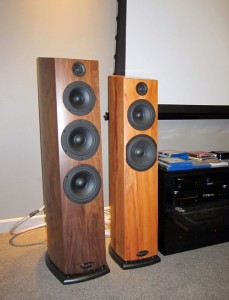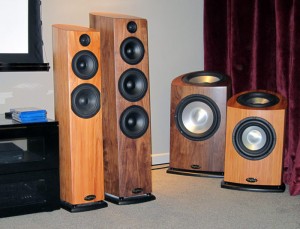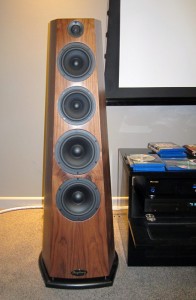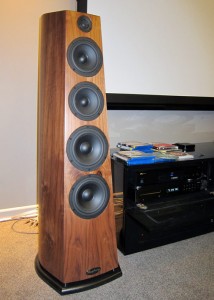
AS DETAILED here, the new Theophany Live showroom is now up and running in Auckland’s Mt Eden. It’s run on a ‘by appointment’ basis and isn’t a walk-in store, because owner Garth Murray believes in doing an in-depth demo wherever possible, and that takes a while. The demo room is set up to showcase the entire Theophany range in both stereo and home theatre, all the way up to a 7.2 system. Because the showroom is also a training venue to support Theophany’s retail partners, the audio components are chosen from ranges accessible to all the stores, so there are no megabuck power amps or exotic pieces of valve gear on offer.
I went into the showroom torn between two extremes. I really wanted to see and hear the new range of Theophany speakers. These really are new from top to bottom, and if new is better, then I’m back in shopping mode. I don’t want to be in shopping mode…
Everything from the drivers and cabinet internals to the crossover designs, points, materials and the internal cabling has changed. Even the binding posts are different. The most notable alteration is the smooth top panel, now bereft of the upward firing driver that for many years was the signature of most of the Theophany Loudspeakers range. That upward firing driver has made me addicted to tall soundstages because I had a pair of them pointing at the roof in my room for years.
My Theophany Series 2 M5 floorstanders have been the source of much joy. I’ve heard them for thousands of hours, mostly on the end of my Viganoni and Viganoni three box monoblock power amps, but the M5s have also been connected to such midlevel luminaries of the amplifier world as Perreaux’s eloquence i250, ATC’s SIA2-50, Plinius’ Hautonga and the much revered LFD LE MkIII, and I never once felt that the speakers were out of their depth (quite the opposite in fact). I’ve also run them on the end of some seriously budget amplification and the M5s proved easy to drive, but revealing of the upstream limitations.

Contrary to the perceptions of some, I’m not brand loyal. In fact, I’m an out-and-out mercenary, being willing to dump any piece of audio gear for a better sounding replacement, no matter how fond I am of the incumbent. Heck, I flogged my precious modified Technics SL-1210 direct drive turntable to buy a Well Tempered Labs Simplex – I loved the Technics, the Simplex looks like it was made in a shed but it sounds much better. End of story, deal done. The M5’s could have been replaced by anything in the $5-$15K range, assuming the replacement did in fact sound better. The fact that it never happened speaks volumes.
So I was conflicted – I didn’t want to contemplate an entirely revised series of speakers, particularly since I knew the others so well. I didn’t want to deal with the missing top driver, and I really wasn’t keen on letting Garth prove his assertion that the changes had made a big improvement to the sound of the speakers. After all, the man was messing with my reference speakers. Then again, I’ve learned to trust Garth’s ears, so I knew I had to give it a shot. Fortunately, I trust my ears even more, so I also knew that if there wasn’t an improvement, I’d be keeping my M5’s for a while. I wanted to hear a tangible improvement, mind you, not just a sideways shift.
While listening and moving speakers around (well, Garth did that and I kept clear so as not to blow up any amplifiers), I managed to get my head around the new model names. After complaining that I preferred the old system because an M5 was obviously bigger and better than an M4, which was ahead of an M3 (etc), Garth pointed out that I think in stereo and that there are people who need to match centre speakers to fronts and then to rears and subwoofers to create a unified home theatre system. I found this hard to believe but assuming he’s right, I see the merit of the new naming protocol. It’s actually easy to follow, take some Greek words and apply them as follows:
Kardia means ‘heart’; the main speakers are the heart of the system, so all the main speakers are “something” Kardia.
Lallia means ‘speech’; the centre speaker handles dialogue, so all the centres are called “something” Lallia.
Kathar means ‘to surround’; the surround speakers are named “something” Kathar, while Kratos means ‘power or dominion’, so the subs are called “something” Kratos.
The three model ranges are Paizo (entry level – ‘to play’), Psallo (mid-range – ‘to sing’) and Psuche (high-end – ‘soul’).
Sitting right at the top are the new flagships – the Rhapsody, which means ‘a piece of music of unusual form’, and the Rhapsody floorstanders definitely do look a little different when compared to the rest of the Theophany designs. At this stage, only the Rhapsody main speakers are available because they’re orientated to very serious stereo systems, and it would be easy to set up a veneer-matched multichannel system using any of the other speakers.
The first speakers we (ex-M5 owner Gary Steel was also in attendance) heard were the $3500 Psallo Kardia floorstanders, driven by Audiolab 8200CDQ CD player/pre-amp combo powering two Audiolab 8200M monoblock power amps using QED cables. The Psallo Kardia features a new 6-inch woofer in its own ported chamber with a 5-inch mid-woofer mounted in a sealed chamber. The tweeter is a 22mm silk dome that runs from around 2500 Hz but extends to 40 kHz and beyond.
I really (really) rated the last Theophany speaker I heard at around this price point – the stand mounted M3b. The Psallo Kardia has a bigger cabinet, additional low frequency extension and bass weight, is easier to drive, is better finished and is basically a more capable speaker. Based even on a short listening session, I think it’s quite the bargain. The overall finish is excellent, as with all the speakers, and the new binding post plate adds a touch of class – I was never wild about the way the old ones just poked out the back of the speaker.
When Garth fired the Psallo Kardias up, I did a double take, hesitated, then got up from the couch to make sure that a) the centre wasn’t running, b) that we were listening to the Psallo model and not the bigger Psuche Kardias sitting alongside them and c) that the subs were off. For a virtually new set that weren’t run in, these things were singing.
As I walked back to my chair, I thought: ‘Damn, he’s done it to me again.’ I’ve been caught double-checking Garth’s systems on occasion, just to reconcile the sound I was hearing to the actual speakers in action. These sound big, with a wide open sound stage that’s actually quite tall; I was expecting it to be massively truncated without that upward firing driver, but that’s not the case. The ability to separate elements of a performance has always been a Theophany strong suit and that’s here in spades, the instruments are eerily distinct (depending on the recording of course), not just in terms of placement but also in retaining their own space in the performance – it’s not just a mashup of sounds.

Switching to the Psuche Kardias showed a distinct step up in just about every imaginable area. I expected this but what I didn’t expect was how much richer they sounded compared to the Psallo Kardias. When I had the M3b model at home, I reviewed it for weeks, then at the end of the review, I lugged my M5’s back in, connected them up to the same system and was amazed at how close the two speakers were in terms of character. The M5’s went far deeper but all in all, the M3b’s were much like a truncated M5.
The Psuche Kardias don’t sound as much like their smaller cousins as I thought they would, their richness is quite remarkable even though the Psallo Kardias are by no means lean. The bigger model carries more power from the midrange down into the low notes and then noticeably extends the deep bass – the missing top firing driver used to make a contribution to the bass but the new 6-inch woofers don’t need any help.
Again, this was a nearly new pair but the audio quality was obvious. They’re very dynamic and capable of the same delicate touches I’m used to on my M5s, with a highly detailed and almost microscopically nuanced ability to render subtle musical cues. Garth has installed very high quality crossover components throughout the range and he reckons that this has made a big difference in many areas. According to him, the new capacitors and air-core inductors are huge, not to mention pricey, but well worth it. Subtle changes to the cabinet shape (externally and internally) have also lifted detail resolution, and the new drivers are lighter and faster than the earlier versions, which has also contributed to the overall improvement. I didn’t really miss the top driver because I never felt as if I was listening to a dwarf rock singer or a band of Hobbits.
Despite all the improvements, the cost of the Psuche Kardias is $6500, which is down on the $6999 that the M5’s used to retail for. Again, not a bad deal at all for the local consumer from what I can tell. In short, I like!

The big $15,000 Rhapsody floorstanders were rolled out next. These are impressive beasts, with a deeply tapered shape that opens up broadly at the bottom and narrows dramatically at the top. The shape has been chosen to totally eliminate parallel surfaces; in fact not one single part of the cabinet has a matching parallel side. This cuts down cabinet resonances to the lowest level yet in a Theophany speaker. Spend some time looking at the angles and consider the constant change in the long joins and you’ll begin to understand why it took over a year just to develop the presses needed to glue and fabricate the Rhapsody cabinets. Two midrange drivers sit below the tweeter, again in their own sealed cabinet, while the new woofers are housed in a bottom-ported cabinet that has a huge internal volume, thanks to that curvy shape.
Sonically – these seem to be a big step up from the Psuche Kardias and that’s in every respect, even with the relatively humble (but rather good) Audiolab combination on the end of them. In a multichannel home theatre system, driven by Pioneer’s LX85 receiver. They were amazing (see Gary Steel’s comments below) but I need more time with a fully run-in set of these speakers, preferably with my amplifiers in front and a fat stack of CDs. Can they compete with equivalently priced exotic speakers? I’m the wrong person to ask that question because I always thought (and still think) that the $7000 M5s were only matched by speakers in the $12-$15K range, so if that ratio is still more or less stable, then the Rhapsody flagships will be killers.
The new subwoofers are also interesting; they use newly designed aluminium drivers powered by Garth’s new custom made 300-watt (Psallo Kratos – 2 x 10-inch drivers) and 500-watt (Psuche Kratos – 2 x 12-inch drivers) amplifiers. The top driver is a passive radiator in both cases, but Garth says having it there, at that specific angle makes a massive difference to the way the subs integrate with a room. The cabinet shape is well removed from the typical square sub and that’s intended to cut resonance right down, along with the special laminated cabinet material.
So after much anticipation, I’m finally getting up to speed on the new range of speakers from Theophany and now that there’s a local showroom, I hope to be able to get some quality time with them, especially the Psuche Kardias, which would be the logical choice to replace my M5s if I think there’s enough in it for me in terms of sonic gains (and I hate to say that I think there is). Gary Steel had the following to say in a recent post on the Witchdoctor forums:
“Having ended up flogging off my Theophany M5s for the wide-screen delights of Martin Logan, I’ve now been sold on Theophany all over again. The new range is more than just a step up on previous models, it’s a revolution. My first thoughts: how effortlessly musical these speakers sounded. Second thoughts: the best home theatre demo I’ve ever heard. I’ll be back for a more extensive listening session, especially of the flagship Rhapsodies.” Even the Wise Electrostatic Curmudgeon of Helensville is impressed – that’s high praise indeed.
Witchdoctor readers keen on a demo in the Auckland showroom can contact Garth Murray directly (contact details are on the site below) or they can just arrange it through their local Harvey Norman store.
















As for those strange tunes Kramer was using to test the speakers… sheesh!
Eh? You have issues with Van Morrison, Nils Lofgren, Nirvana and Neil Young? Too mainstream for you? You’re a hipster Steel!
I bought a set of Kardia last year to replace my quake damaged Tannoys, and I had to audition them in a Harvey Norman shop with people all around me including someone behind me doing the vacuuming, and within 20 mins I had fallen in love. They have transformed my listening experience and my one complaint is that they make getting up from the sofa before a cd is finished bloody near impossible.